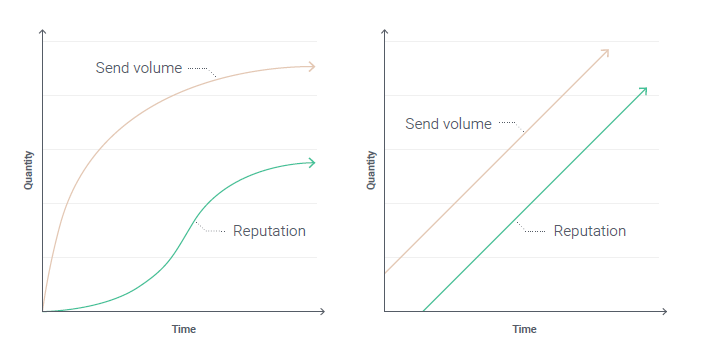Warming-up Your IP Address
Warming an IP address is essential for reputation with Email Services Providers (ESPs). The process of methodically adding campaign volume week-over-week to your IP is known as IP Warm-up.
When you first start sending email from a new IP address, ESPs immediately detect it and consider it suspicious until they establish a positive sending reputation. Usually it takes from four to eight weeks, sometimes even longer to achieve the best deliverability. Most of the providers will limit you right to thresholds until you build a sender reputation.
At Wooxy.com, we recommend that you start sending off with your cleanest contacts first, focusing on your most engaged subscribers. Your older segments can be added in portions as small as 15% of your existing volume. This will help to secure your good reputation.
To be more clear: start sending to the subscribers, who are least likely to complain, such as the newly opted-in ones and those who consistently open/click your emails.
This is the phase, when the more consistent you are with volume, frequency, complaint and bounce levels, the faster you will establish a positive sending reputation. And vice versa: infrequent campaigns, anything less than weekly, will keep you back from building a positive sender reputation.
IP Warm-up Plan is your key to success, so check out this Warm-up Schedule to nail it from the very beginning.
What’s next?
Once you start warming up your IP address, there’s still a chance of some bulking and blocking on your way. Don’t panic and stick with the plan.
- Bulking at Yahoo, AOL, Gmail is usually inevitable, and it should clear up after a few sends with solid positive metrics. Be ready to sweat it out before getting delivered to inbox. The key is to keep sending to engaged subscribers.
- There will be some delays at AOL, Microsoft and Comcast. It is quite normal, and as a rule, it will lessen day by day, as your reputation develops. The delays, known as 421 bounces, will retry for 72 hours and if not delivered will bounce as a 5XX with the original 421 error in the bounce record. However if the delays are timing out in large quantities you should back down your volumes to that ESP by tightening up your engagement.
- ESPs will most likely block your sends, in case if your list isn’t engaged enough. Take a deep breath, segment carefully, tighten up engagement and keep sending.
Remember to continuously monitor your metrics and adjust the plan accordingly during the entire warm-up period.
Is there a difference between Quick and Slow Warm-Up?
Sure there is.
In case you are impatient and prefer a quicker warm-up, the ESPs will:
- See volume spikes
- Consider you as an unknown sender
- Block/Filter/limit your Rate

On the other hand, a little bit of patience will be rewarded. The ESPs will:
- See the gradual build in volume
- Grant you with good reputation over time
- Rarely Block/Filter/limit your Rate.
Here are the sacred rules from ‘Smart Senders’ Bible’, which will grant you the desired access to the inbox:
Bad reputation = Spam Folder or Blocks
Good reputation = Inbox
Reputation can affect the Domain and/or IP Address based on:
- Spam Complaints
- Invalid email addresses (hard bounces)
- Spamtrap hits
- Authentication (SPF, Sender ID, DKIM, DMARC)
- Third-party blacklistings
- Engagement
Positive Reputation is based on:
- Opens
- Clicks
- Authentication – DKIM, SPF, Sender ID, DMARC
Negative Reputation comes from:
- Poor or insufficient permission
- High recipient complaints (report as spam)
- Poor list quality/hygiene – Bad email addresses
- IP Address and Domain blacklistings
- Spam Trap hits
- Large spikes in volume
Key Takeaways:
1. Opt-ins are essential priority
If you send to people, who do not want your mail, your reputation will inevitably suffer.
Receivers and metrics are your golden ticket to the inbox.
2. You can not transfer your reputation from your old IP.
If you use the same domain, that reputation can follow you, however receivers like Gmail use the reputation of the domain coupled with the reputation of the IP, thus you must follow the warm-up process either way.
3. Your Brand have no power over your reputation.
ESPs trust metrics from their users and what they observe. B2B senders must follow the same warm-up process.
4. ESPs track how engaged subscribers are with an email and its sender, and the nature of the engagement.
Opt-in maximizes the likelihood of engagement, because theoretically there is already a certain relationship established with the receiver.
5. Quality always wins out over Quantity. Send relevant content to engaged subscribers.
Set subscribers’ expectations from the beginning. Give people who opt- in to your subscription lists choices on how often they’ll receive emails from you. Ask them to whitelist you as they opt-in.
6. Keep your lists clean.
This will help you avoid Spam Traps, the Email addresses created solely to capture spammers (sometimes referred to as Honey Pots). Do not purchase or rent lists. Remove hard bounces.
Continuously re-engaged your inactive subscribers. Remove disengaged subscribers once several re-engagement attempts have been made.




